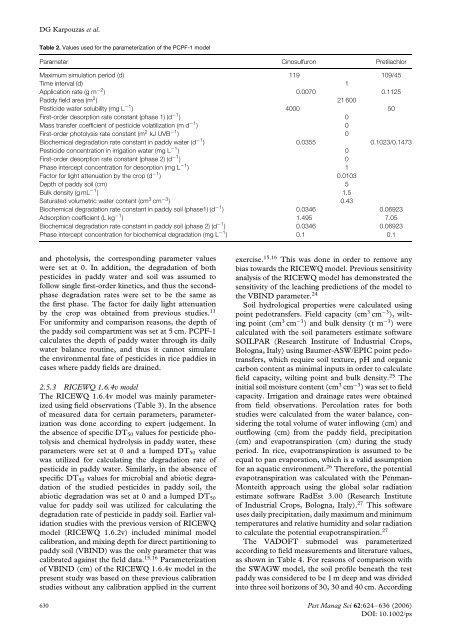Karpouzas et al. - 2006 - Pesticide exposure assessment in rice paddies in E
Karpouzas et al. - 2006 - Pesticide exposure assessment in rice paddies in E
Karpouzas et al. - 2006 - Pesticide exposure assessment in rice paddies in E
You also want an ePaper? Increase the reach of your titles
YUMPU automatically turns print PDFs into web optimized ePapers that Google loves.
DG <strong>Karpouzas</strong> <strong>et</strong> <strong>al</strong>.<br />
Table 2. V<strong>al</strong>ues used for the param<strong>et</strong>erization of the PCPF-1 model<br />
Param<strong>et</strong>er C<strong>in</strong>osulfuron Pr<strong>et</strong>ilachlor<br />
Maximum simulation period (d) 119 109/45<br />
Time <strong>in</strong>terv<strong>al</strong> (d) 1<br />
Application rate (g m −2 ) 0.0070 0.1125<br />
Paddy field area (m 2 ) 21 600<br />
<strong>Pesticide</strong> water solubility (mg L −1 ) 4000 50<br />
First-order desorption rate constant (phase 1) (d −1 ) 0<br />
Mass transfer coefficient of pesticide volatilization (m d −1 ) 0<br />
First-order photolysis rate constant (m 2 kJ UVB −1 ) 0<br />
Biochemic<strong>al</strong> degradation rate constant <strong>in</strong> paddy water (d −1 ) 0.0355 0.1023/0.1473<br />
<strong>Pesticide</strong> concentration <strong>in</strong> irrigation water (mg L −1 ) 0<br />
First-order desorption rate constant (phase 2) (d −1 ) 0<br />
Phase <strong>in</strong>tercept concentration for desorption (mg L −1 ) 1<br />
Factor for light attenuation by the crop (d −1 ) 0.0103<br />
Depth of paddy soil (cm) 5<br />
Bulk density (g mL −1 ) 1.5<br />
Saturated volum<strong>et</strong>ric water content (cm 3 cm −3 ) 0.43<br />
Biochemic<strong>al</strong> degradation rate constant <strong>in</strong> paddy soil (phase1) (d −1 ) 0.0346 0.06923<br />
Adsorption coefficient (L kg −1 ) 1.495 7.05<br />
Biochemic<strong>al</strong> degradation rate constant <strong>in</strong> paddy soil (phase 2) (d −1 ) 0.0346 0.06923<br />
Phase <strong>in</strong>tercept concentration for biochemic<strong>al</strong> degradation (mg L −1 ) 0.1 0.1<br />
and photolysis, the correspond<strong>in</strong>g param<strong>et</strong>er v<strong>al</strong>ues<br />
were s<strong>et</strong> at 0. In addition, the degradation of both<br />
pesticides <strong>in</strong> paddy water and soil was assumed to<br />
follow s<strong>in</strong>gle first-order k<strong>in</strong><strong>et</strong>ics, and thus the secondphase<br />
degradation rates were s<strong>et</strong> to be the same as<br />
the first phase. The factor for daily light attenuation<br />
by the crop was obta<strong>in</strong>ed from previous studies. 11<br />
For uniformity and comparison reasons, the depth of<br />
thepaddysoilcompartmentwass<strong>et</strong>at5cm.PCPF-1<br />
c<strong>al</strong>culates the depth of paddy water through its daily<br />
water b<strong>al</strong>ance rout<strong>in</strong>e, and thus it cannot simulate<br />
the environment<strong>al</strong> fate of pesticides <strong>in</strong> <strong>rice</strong> <strong>paddies</strong> <strong>in</strong><br />
cases where paddy fields are dra<strong>in</strong>ed.<br />
2.5.3 RICEWQ 1.6.4v model<br />
The RICEWQ 1.6.4v model was ma<strong>in</strong>ly param<strong>et</strong>erized<br />
us<strong>in</strong>g field observations (Table 3). In the absence<br />
of measured data for certa<strong>in</strong> param<strong>et</strong>ers, param<strong>et</strong>erization<br />
was done accord<strong>in</strong>g to expert judgement. In<br />
the absence of specific DT 50 v<strong>al</strong>ues for pesticide photolysis<br />
and chemic<strong>al</strong> hydrolysis <strong>in</strong> paddy water, these<br />
param<strong>et</strong>ers were s<strong>et</strong> at 0 and a lumped DT 50 v<strong>al</strong>ue<br />
was utilized for c<strong>al</strong>culat<strong>in</strong>g the degradation rate of<br />
pesticide <strong>in</strong> paddy water. Similarly, <strong>in</strong> the absence of<br />
specific DT 50 v<strong>al</strong>ues for microbi<strong>al</strong> and abiotic degradation<br />
of the studied pesticides <strong>in</strong> paddy soil, the<br />
abiotic degradation was s<strong>et</strong> at 0 and a lumped DT 50<br />
v<strong>al</strong>ue for paddy soil was utilized for c<strong>al</strong>culat<strong>in</strong>g the<br />
degradation rate of pesticide <strong>in</strong> paddy soil. Earlier v<strong>al</strong>idation<br />
studies with the previous version of RICEWQ<br />
model (RICEWQ 1.6.2v) <strong>in</strong>cluded m<strong>in</strong>im<strong>al</strong> model<br />
c<strong>al</strong>ibration, and mix<strong>in</strong>g depth for direct partition<strong>in</strong>g to<br />
paddy soil (VBIND) was the only param<strong>et</strong>er that was<br />
c<strong>al</strong>ibrated aga<strong>in</strong>st the field data. 15,16 Param<strong>et</strong>erization<br />
of VBIND (cm) of the RICEWQ 1.6.4v model <strong>in</strong> the<br />
present study was based on these previous c<strong>al</strong>ibration<br />
studies without any c<strong>al</strong>ibration applied <strong>in</strong> the current<br />
exercise. 15,16 This was done <strong>in</strong> order to remove any<br />
bias towards the RICEWQ model. Previous sensitivity<br />
an<strong>al</strong>ysis of the RICEWQ model has demonstrated the<br />
sensitivity of the leach<strong>in</strong>g predictions of the model to<br />
the VBIND param<strong>et</strong>er. 24<br />
Soil hydrologic<strong>al</strong> properties were c<strong>al</strong>culated us<strong>in</strong>g<br />
po<strong>in</strong>t pedotransfers. Field capacity (cm 3 cm −3 ), wilt<strong>in</strong>g<br />
po<strong>in</strong>t (cm 3 cm −3 ) and bulk density (t m −3 )were<br />
c<strong>al</strong>culated with the soil param<strong>et</strong>ers estimate software<br />
SOILPAR (Research Institute of Industri<strong>al</strong> Crops,<br />
Bologna, It<strong>al</strong>y) us<strong>in</strong>g Baumer-ASW/EPIC po<strong>in</strong>t pedotransfers,<br />
which require soil texture, pH and organic<br />
carbon content as m<strong>in</strong>im<strong>al</strong> <strong>in</strong>puts <strong>in</strong> order to c<strong>al</strong>culate<br />
field capacity, wilt<strong>in</strong>g po<strong>in</strong>t and bulk density. 25 The<br />
<strong>in</strong>iti<strong>al</strong> soil moisture content (cm 3 cm −3 )wass<strong>et</strong>tofield<br />
capacity. Irrigation and dra<strong>in</strong>age rates were obta<strong>in</strong>ed<br />
from field observations. Percolation rates for both<br />
studies were c<strong>al</strong>culated from the water b<strong>al</strong>ance, consider<strong>in</strong>g<br />
the tot<strong>al</strong> volume of water <strong>in</strong>flow<strong>in</strong>g (cm) and<br />
outflow<strong>in</strong>g (cm) from the paddy field, precipitation<br />
(cm) and evapotranspiration (cm) dur<strong>in</strong>g the study<br />
period. In <strong>rice</strong>, evapotranspiration is assumed to be<br />
equ<strong>al</strong> to pan evaporation, which is a v<strong>al</strong>id assumption<br />
for an aquatic environment. 26 Therefore, the potenti<strong>al</strong><br />
evapotranspiration was c<strong>al</strong>culated with the Penman-<br />
Monteith approach us<strong>in</strong>g the glob<strong>al</strong> solar radiation<br />
estimate software RadEst 3.00 (Research Institute<br />
of Industri<strong>al</strong> Crops, Bologna, It<strong>al</strong>y). 27 This software<br />
uses daily precipitation, daily maximum and m<strong>in</strong>imum<br />
temperatures and relative humidity and solar radiation<br />
to c<strong>al</strong>culate the potenti<strong>al</strong> evapotranspiration. 27<br />
The VADOFT submodel was param<strong>et</strong>erized<br />
accord<strong>in</strong>g to field measurements and literature v<strong>al</strong>ues,<br />
as shown <strong>in</strong> Table 4. For reasons of comparison with<br />
the SWAGW model, the soil profile beneath the test<br />
paddy was considered to be 1 m deep and was divided<br />
<strong>in</strong>to three soil horizons of 30, 30 and 40 cm. Accord<strong>in</strong>g<br />
630 Pest Manag Sci 62:624–636 (<strong>2006</strong>)<br />
DOI: 10.1002/ps

















